Knowing how to cook whole spaghetti squash is a great way to enjoy a delicious and healthy alternative to pasta. It’s easy to make, incredibly versatile, and much more nutritious than regular spaghetti. In this post, we will guide you through the process step-by-step so that you can make whole spaghetti squash in no time!
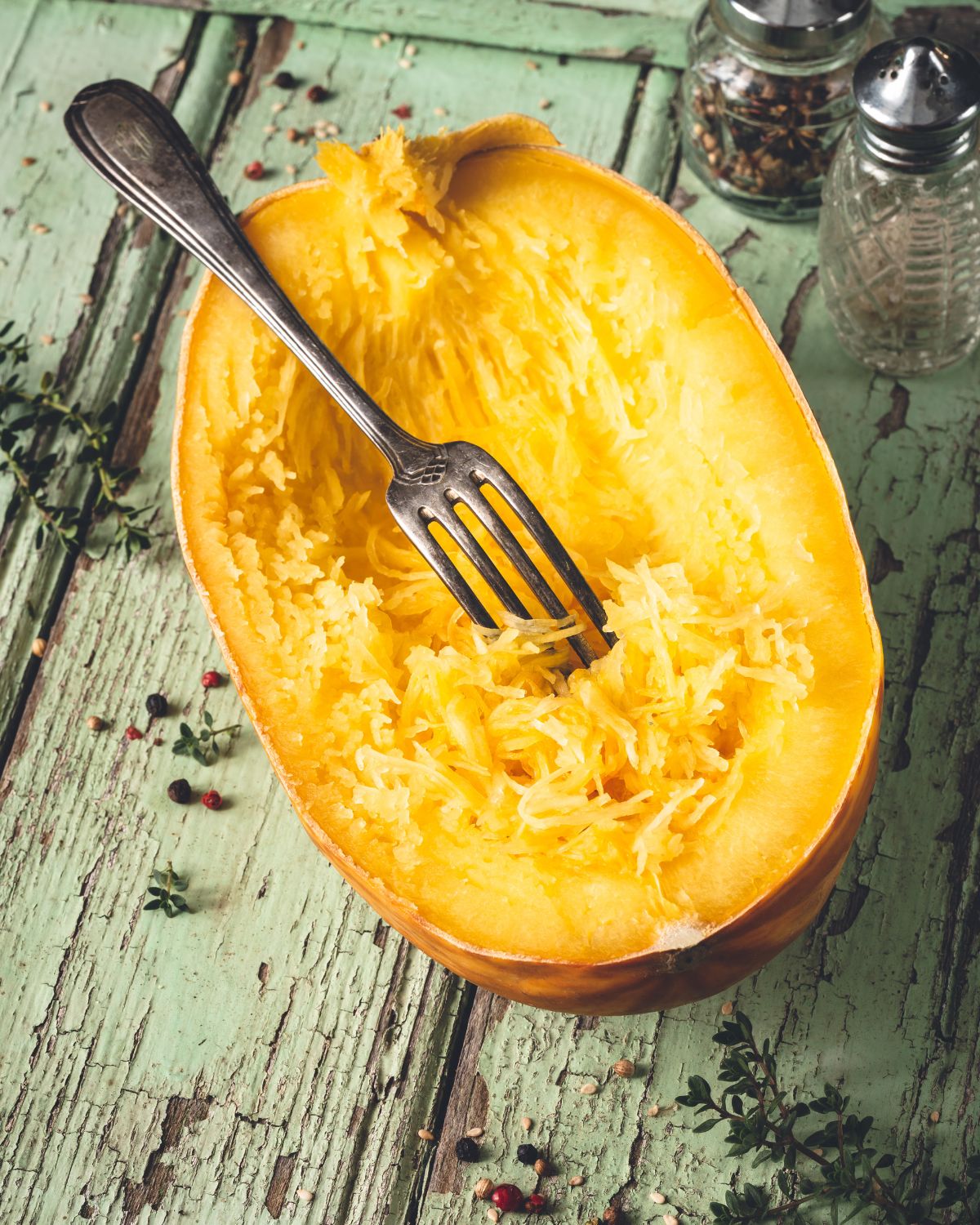
SAVE THIS RECIPE!
Enter your email below and we’ll send this recipe straight to your inbox.
Whole spaghetti squash is a delicious and versatile vegetable that can be used in a variety of dishes. Whether you are looking for a gluten-free alternative to pasta or simply want to add more vegetables to your diet, spaghetti squash is an excellent option. However, many people are intimidated by the thought of preparing this unique vegetable. In this article, we will walk you through the process of making whole spaghetti squash so that you can enjoy it at home.
Healthline details just how great spaghetti squash is, and why you should include it in your diet. It is a great alternative to pasta, and their article goes into detail as to why!
If you’re looking for a recipe that uses spaghetti squash, try this Spaghetti Squash Salad.
Why We Love Spaghetti Squash
We love spaghetti squash because of how delicious it is while still maintaining its nutritious value, versatility, and affordability! Spaghetti squash in place of pasta is something that we love about this vegetable as well, as its unique texture closely resembles that of pasta while being low carb and low calorie.
- Nutritious: Spaghetti squash is a low-calorie, nutrient-dense food, meaning it is a great source of several vitamins and minerals. In particular, spaghetti squash is a great source of pantothenic acid. It is also a good source of fiber, vitamin C, manganese, vitamin B6, and niacin.
- Versatile: One of the key benefits of spaghetti squash is its versatility in cooking. It can be roasted, boiled, microwaved or even cooked in the Instant Pot. Once cooked, you can use it as a base for salads or add it to soups and stews. You can also mix it with other vegetables and proteins to create hearty main dishes like casseroles or stir-fries.
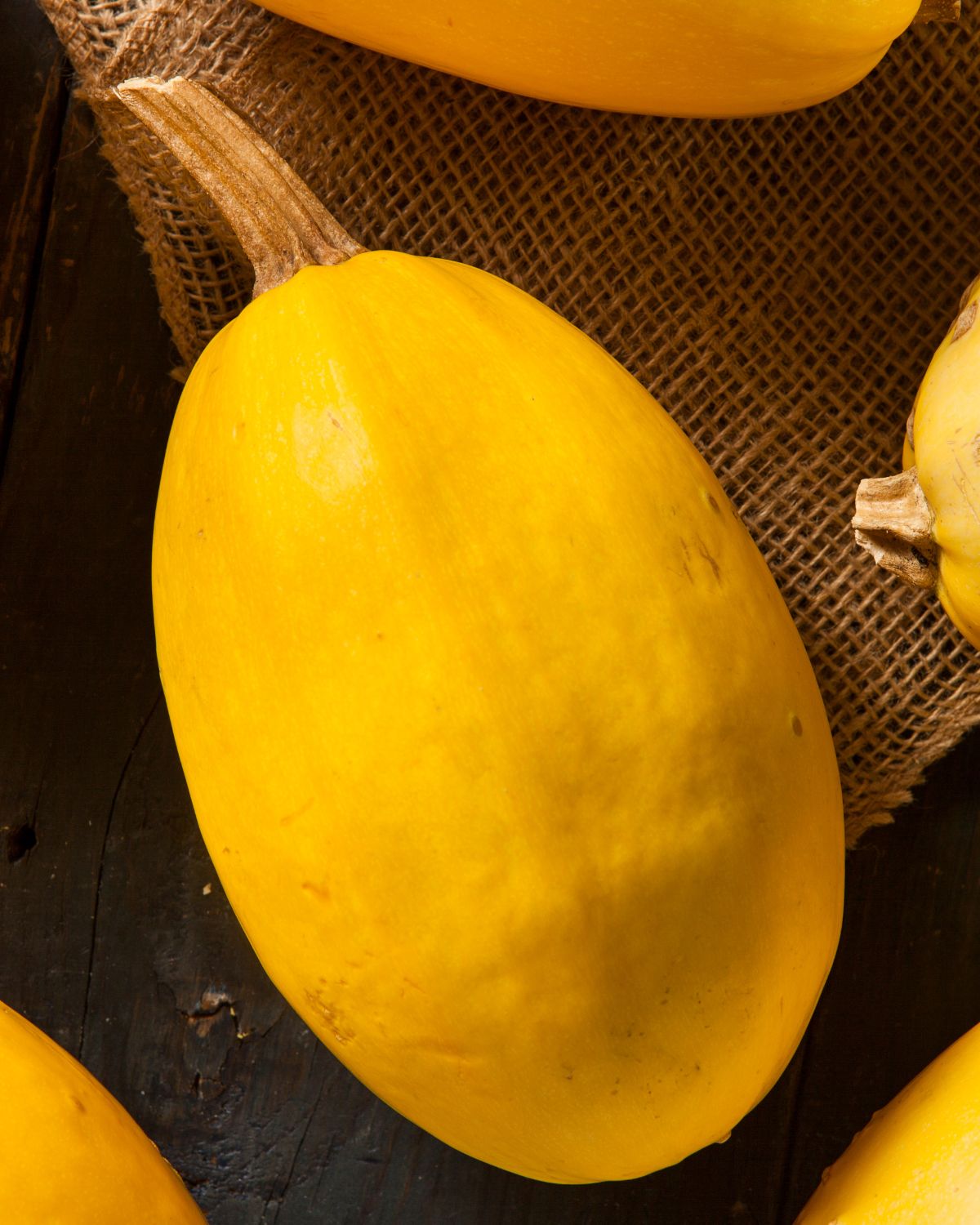
- Freezer Friendly: Freezing spaghetti squash helps to preserve its nutrients and flavor, making it an ideal option for people who want to maintain a healthy diet without sacrificing taste. When properly stored, spaghetti squash can last up to six months in the freezer, making it an excellent choice for meal prepping or saving leftovers.
- Adaptable: Spaghetti squash has a very mild flavor that can easily take on the flavors of whatever it’s cooked with. This makes it perfect for use in savory dishes where it can absorb the delicious tastes of sauces, spices, and herbs. Secondly, spaghetti squash has a unique texture that resembles noodles when cooked properly. This noodle-like texture makes it an excellent alternative to traditional pasta for those who want to cut down on carbs or eat gluten-free.
- Affordable: What makes spaghetti squash particularly appealing is its affordability. Unlike other trendy superfoods that come with a hefty price tag, spaghetti squash can be found at most grocery stores for an affordable price. One reason for spaghetti squash’s affordability is its availability. This vegetable is relatively easy to grow and harvest, making it more accessible than some of its pricier counterparts like kale or avocados. Additionally, because spaghetti squash has a longer shelf life than many other vegetables, it doesn’t require the same level of care and attention during transport or storage which helps keep costs down.
What is Spaghetti Squash
Spaghetti squash is a type of winter squash that has gained popularity in recent years as a healthy and low-carb alternative to traditional pasta. It gets its name from the fact that, once cooked, the flesh of the squash separates into long strands that resemble spaghetti noodles. Spaghetti squash is also known by several other names, including vegetable spaghetti, noodle squash, and squaghetti.
Spaghetti squash is native to Central America and Mexico but can now be found in most parts of the world. It has a hard outer shell with a pale yellow or orange flesh inside. The flesh contains many vitamins and minerals such as vitamin A, potassium, and fiber. Additionally, spaghetti squash is low in calories with only 31 calories per cup compared to traditional pasta which can have over 200 calories per cup.
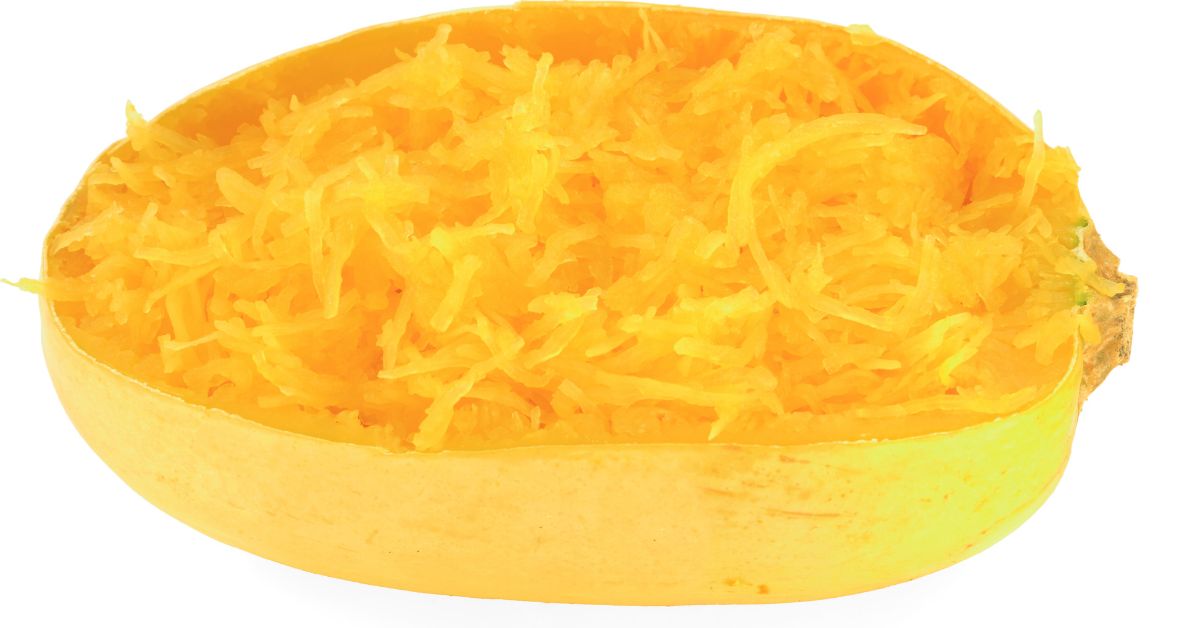
Types of Spaghetti Squash
- Ivory: This unique variety of squash has a smooth, ivory-colored exterior and a stringy, spaghetti-like interior when cooked. The flesh of the ivory spaghetti squash is slightly sweet and nutty, making it an excellent addition to any dish. One of the best things about ivory spaghetti squash is its versatility in the kitchen. It can be roasted, baked, microwaved or boiled – all with great results. It can also be served in many ways: topped with tomato sauce and cheese as a healthier version of pasta, or mixed with herbs and spices for a savory side dish.
- Yellow: Yellow spaghetti squash, also known as vegetable spaghetti, is a type of winter squash that is similar in texture and appearance to traditional pasta. This variety of squash has a firm, thin flesh and a rich yellow color that make it an excellent substitute for traditional noodles or spaghetti. It’s low in calories and high in fiber, making it a healthy addition to any diet. Yellow spaghetti squash can be cooked in a variety of ways including baking, boiling, or microwaving. When cooked properly, the flesh easily separates into long strands resembling thin noodles. These “noodles” are perfect for use in dishes such as stir-fries or casseroles where they absorb the flavors of other ingredients well. Additionally, yellow spaghetti squash can be a base for sauces or served simply with olive oil and Parmesan cheese for a delicious side dish.
- Orange: Orange spaghetti squash is a type of winter squash that has become increasingly popular in recent years. It is know as vegetable spaghetti or noodle squash due to its stringy flesh, which resembles spaghetti noodles. The flesh of the orange spaghetti squash is bright orange in color and has a slightly sweet flavor. This versatile vegetable can be roasted, baked, boiled, steamed or even microwaved. Once you cook, it can be a healthy substitute for pasta and pairs well with sauces such as tomato or pesto. Additionally, you can enjoy on its own with some butter and seasonings.
Benefits of Spaghetti Squash
- Benefit 1: Spaghetti squash is an excellent source of vitamins and minerals. It contains high levels of vitamin C, which helps to support your immune system and promotes healthy skin.
- Benefit 2: It is rich in potassium which aids in regulating blood pressure and maintaining healthy heart function.
- Benefit 3: Spaghetti squash is full of antioxidants such as beta-carotene and lutein. These antioxidants help to protect your body against harmful free radicals that can contribute to chronic diseases such as cancer and heart disease.
How to Cook Whole Spaghetti Squash
There are so many ways to cook your spaghetti squash. Whether this be in the microwave, oven, instant pot, air fryer, or even grilled, cooking whole spaghetti squash is a delicious alternative to regular spaghetti. Here are a few methods in cooking your spaghetti squash.
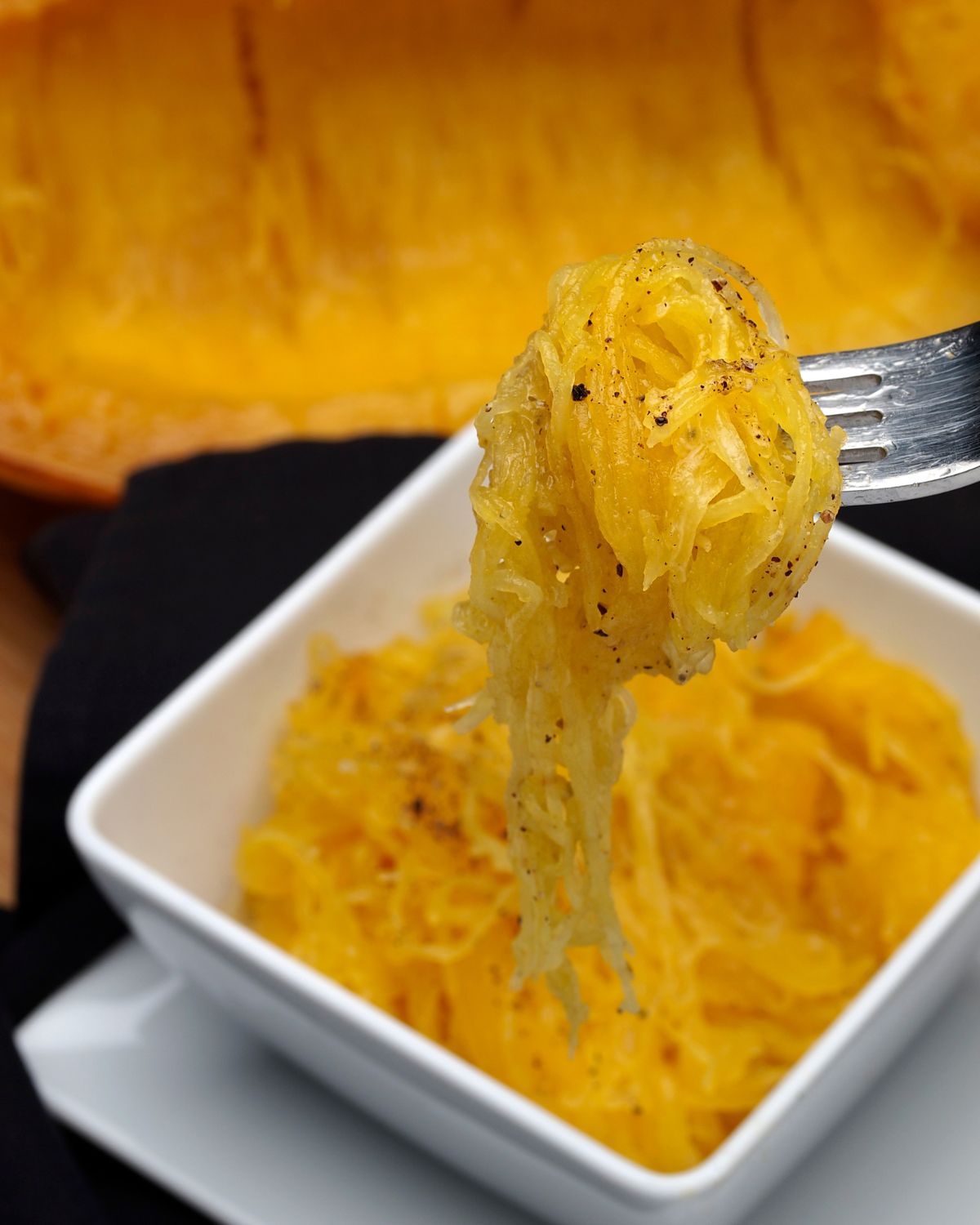
Oven Method
Step 1: Prep the Essentials
First, prep your oven to 375 degrees.
Then, prep your squash by poking holes into it with a sharp knife.
You will then want to place your whole squash on a rimmed baking sheet.
Step 2: Cooking Instructions
Once you place your whole squash into the oven, cook for 45-60 minutes.
Flip your squash halfway through to allow even cooking.
Step 3: Final Steps
Remove from the oven, allow your squash to sit for about 20 minutes.
Once cool enough to handle, cut your squash in half.
Cut, remove the seeds from the center and throw them away.
Lastly, use a fork to remove the “pasta strands”.
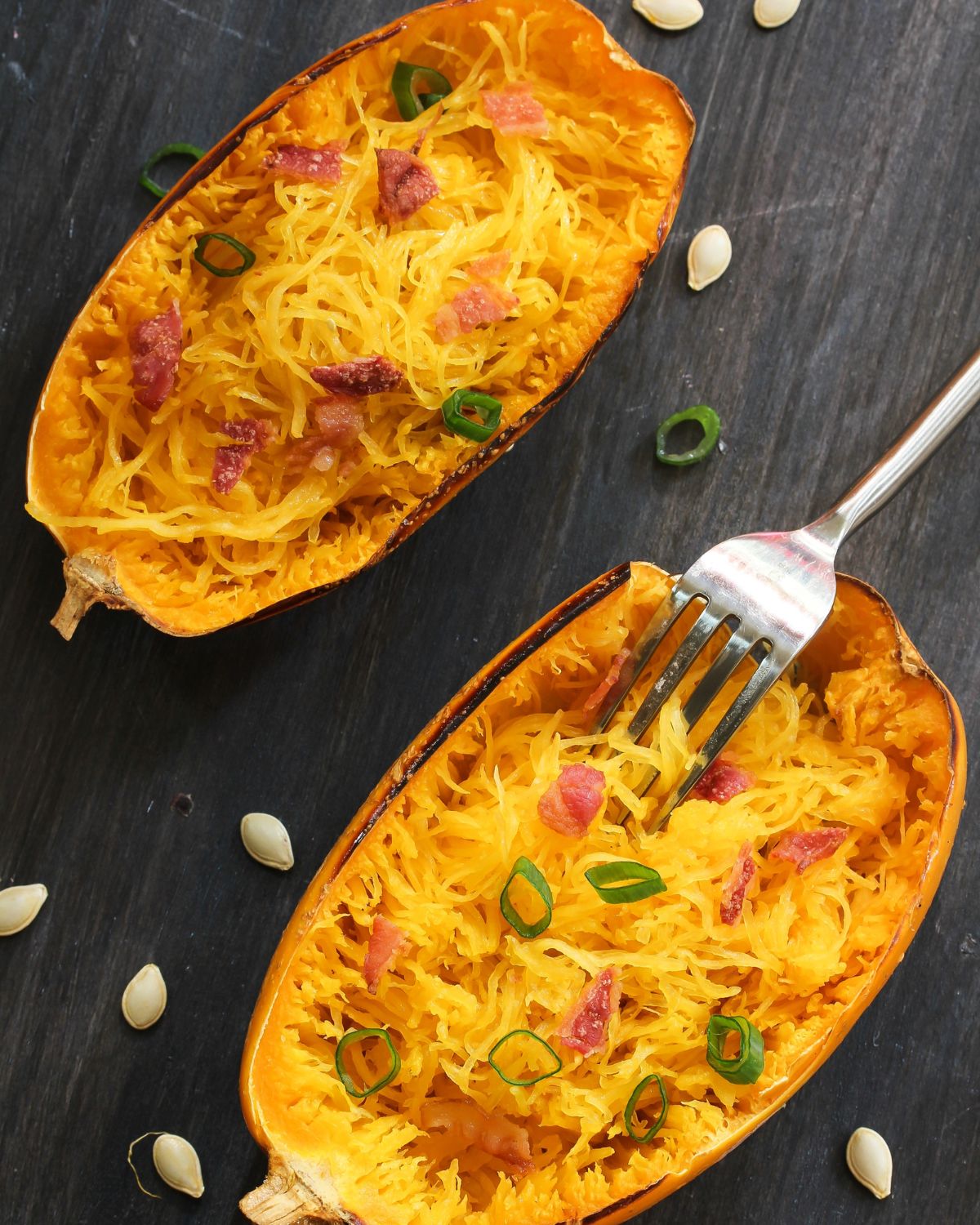
Instant Pot Method
Step 1: Prep the Essentials
First, place a cup of water into the stainless steel insert of your Instant Pot.
Place the trivet on top.
Next, poke holes into your spaghetti squash using a sharp knife.
note: you can only fit a 2lb or 3lb spaghetti squash in a 6 quart model.
Step 2: Cooking Instructions
Place your squash into the Instant Pot and cook on high pressure for 20-25 minutes.
Next, release the pressure and check and see if your squash is done.
Microwave Method
Step 1: Prep your squash
Prep your whole spaghetti squash by poking holes all around the squash using a sharp knife.
Step 2: Cooking Instructions
Place your squash into the microwave and heat on high in 5 minute increments.
Every 5 minutes, rotate your squash so the heating is even throughout.
Cooking should take anywhere between 10-20 minutes, depending on how soft you would like your spaghetti squash to be, and depending on the size of your squash.
FAQs
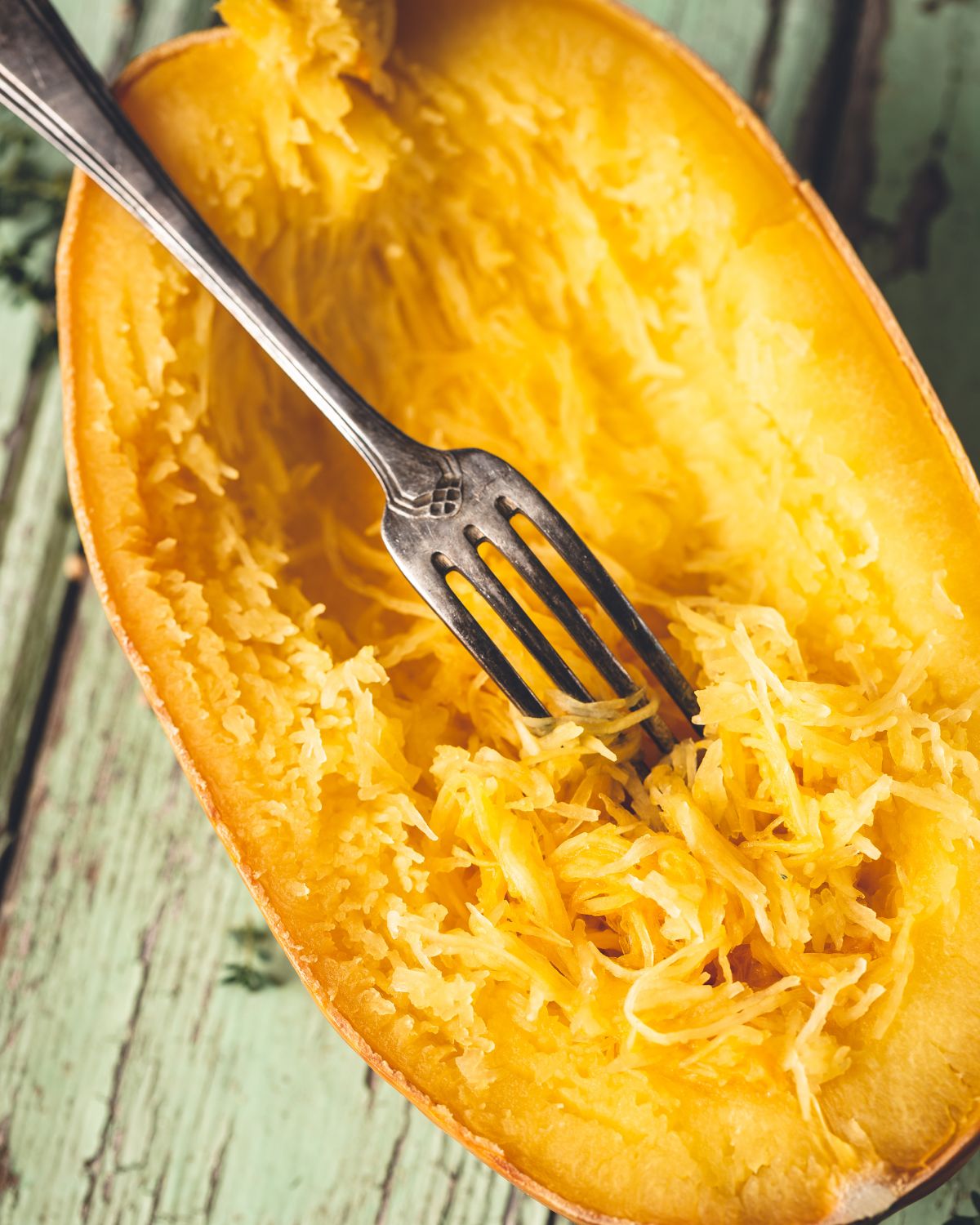
Expert Tips for How to Cook Whole Spaghetti Squash
- Tip 1: If you want to avoid mushy noodles, Salt the spaghetti squash first to draw out moisture: Letting cut spaghetti squash sit with coarse salt on it for 15-20 minutes draws out a ton of moisture from inside the squash. Less moisture = less mushy noodles.
- Tip 2: Don’t over salt your squash. Watery spaghetti squash was typically has salt too much before baking. Adding too much oil before roasting can also cause spaghetti squash to become soggy while baking, or your may have cooked your squash for too long.
- Tip 3: If your squash is particularly small, check after 10 minutes just to ensure you don’t overcook it. To check for doneness, flip one half of the spaghetti squash over and run a fork down the top edge of the squash.
Spaghetti Squash Recipes to Try
⭐️ ⭐️ ⭐️ ⭐️ ⭐️
Did you try this?
Please leave a star rating and review below!
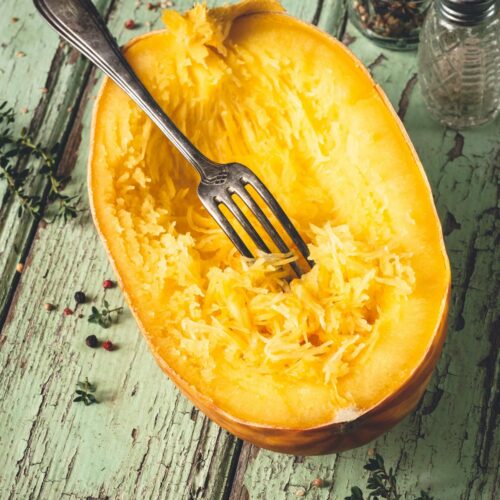
How to Cook Whole Spaghetti Squash
Equipment
Materials
- 1 whole spaghetti squash
Instructions
- Oven MethodStep 1: Prep the EssentialsFirst, prep your oven to 375 degrees. Then, prep your squash by poking holes into it with a sharp knife. You will then want to place your whole squash on a rimmed baking sheet.
- Step 2: Cooking InstructionsOnce you place your whole squash into the oven, cook for 45-60 minutes.Flip your squash halfway through to allow even cooking.
- Step 3: Final StepsOnce removed from the oven, allow your squash to sit for about 20 minutes. Once cool enough to handle, cut your squash in half.Once cut, remove the seeds from the center and throw them away. Lastly, use a fork to remove the “pasta strands”.Enjoy!
- Instant Pot MethodStep 1: Prep the EssentialsFirst, place a cup of water into the stainless steel insert of your Instant Pot.Place the trivet on top. Next, poke holes into your spaghetti squash using a sharp knife. note: you can only fit a 2lb or 3lb spaghetti squash in a 6 quart model.
- Step 2: Cooking InstructionsPlace your squash into the Instant Pot and cook on high pressure for 20-25 minutes.Next, release the pressure and check and see if your squash is cooked to how you would like it.
- Microwave MethodStep 1: Prep Your SquashPrep your whole spaghetti squash by poking holes all around the squash using a sharp knife.
- Step 2: Cooking InstructionsPlace your squash into the microwave and heat on high in 5 minute increments. Every 5 minutes, rotate your squash so the heating is even throughout. Cooking should take anywhere between 10-20 minutes, depending on how soft you would like your spaghetti squash to be, and depending on the size of your squash.
Expert Tips
Expert Tips for How to Cook Whole Spaghetti Squash
- Tip 1: If you want to avoid mushy noodles, Salt the spaghetti squash first to draw out moisture: Letting cut spaghetti squash sit with coarse salt on it for 15-20 minutes draws out a ton of moisture from inside the squash. Less moisture = less mushy noodles.
- Tip 2: Don’t over salt your squash. Watery baked spaghetti squash was typically salted too heavily before baking. Adding too much oil before roasting can also cause spaghetti squash to become soggy while baking, or your may have cooked your squash for too long.
- Tip 3: If your squash is particularly small, check after 10 minutes just to ensure you don’t overcook it. To check for doneness, flip one half of the spaghetti squash over and run a fork down the top edge of the squash.


